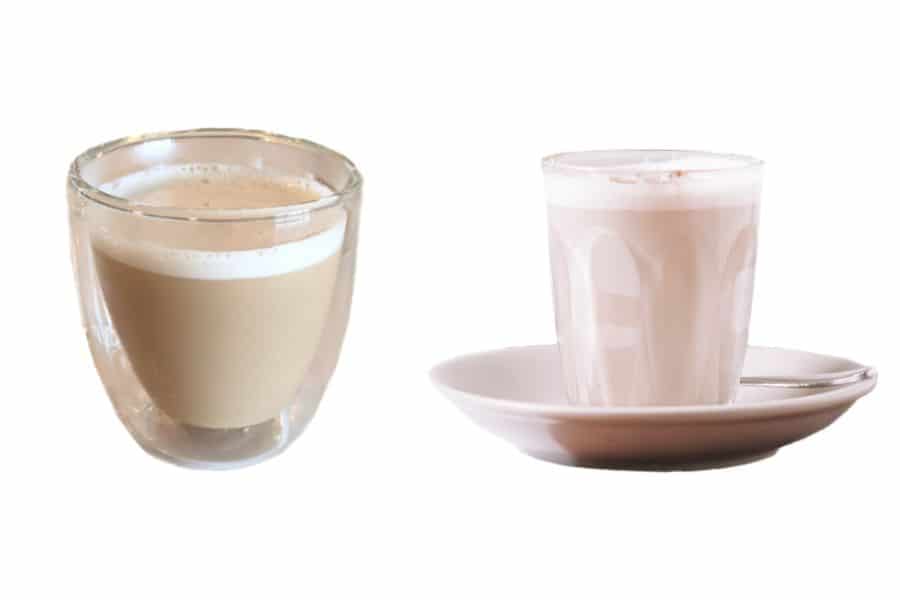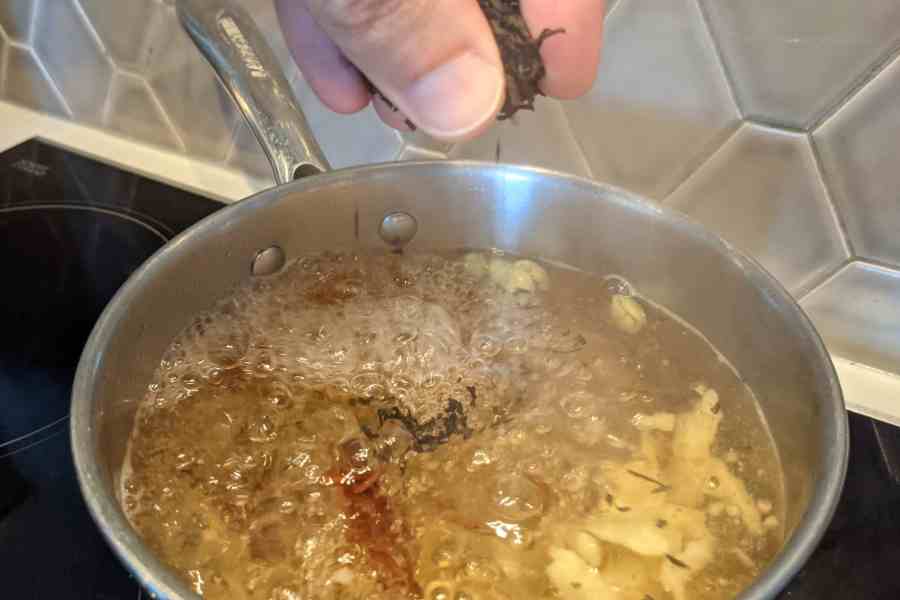Chai is not only a blend of spices but a blend of cultures too. It combines centuries-old spices and traditions. Today, chai is part of the menu of every other coffee shop. Why the two names, and what’s the difference between chai tea vs chai latte?
In this post, we’ll do a deep dive into the aromatic world of Chai, both in tea and latte form. Also, stay tuned for an authentic chai tea recipe that will you feeling like you’re in the bustling streets of Dehli.

Topics Explored
- What is Chai Tea?
- What is a Chai Latte?
- Differences Between Chai Tea & Chai Latte
- How To Make Authentic Chai Tea At Home
- More Questions
What is Chai Tea?
Chai tea, also called masala chai, is made with black tea, a masala mix of spices, water, sweetener of choice, and buffalo or cow milk.
The masala mixture usually contains cardamom, ginger, cloves, cinnamon, and black peppercorns. Chai tea uses more water than milk in the making.
Chai tea is believed to date 5,000 years ago when a king asked for an Ayurvedic spice remedy for cold. It was popularised thousands of years later when the Brits planted tea farms around India.
This is the period when black tea, milk, and sweetener were also added to the recipe.

What is a Chai Latte?
Chai latte is made with more milk than water and other additions that are not typical for authentic chai.
These days it’s not uncommon to make it from premixed instant powder and add syrups or other flavorings. As a result, Chai latte is more modern and customizable – you can make it with any milk and flavors.

As Chai’s westernized contemporary version, Chai latte was introduced by Starbucks in the 1990s. After it gained massive popularity, it sparked an up-sale of spices needed for at-home chai lattes.
As a result, today, you can find chai-infused black tea in most supermarkets.
Chai Tea vs Chai Latte
Think you can tell the difference between the two?
To an average person that consumes both drinks casually, they’re the same, and it’s hard to tell them apart. But to tea enthusiasts and traditionalists, there are notable differences.
| Chai Tea | Chai Latte |
|---|---|
| Composition: Amount of milk doesn’t exceed tea. |
Composition Ratio of milk to tea is greater than 1:1 |
| Made With: – Black Tea (Darjeeling/Assam) – Spice Blend – Buffalo or Cow’s Milk – Sugar |
Made With: – Black Tea – Spice Blend – Any Milk – Sugar or Syrup – Additional Flavoring |
| Beige with light viscosity. Thin or loose milk froth on top. |
Pale beige with velvety consistency. Thick and dry froth on top. |
| – Stronger tea & spice flavor – Milk rounds out profile – Served hot |
– Creamy – Tea & spices take backseat – Served hot or cold |
| Subtle ingredient variations by region. e.g. spice blend or milk to tea ratio |
Can be transformed to new drink types. e.g. Eggnog Chai or Dirty Chai |
| From: India |
From: Indian origin but with Western twists |
1. Ingredients
The essential spices in the Masala mix are cinnamon, cardamom, ginger, cloves, and peppercorns. This mix determines what the chai tea would taste like. Chai tea is also originally made using buffalo milk.
Chai latte has the same base ingredients, plus other non-traditional parts. For example, you can make it with nut milk or add chocolate, espresso, vanilla, or peppermint flavorings.

2. Composition
There isn’t a strict recipe or composition for preparing Chais, unlike coffee or cocktails. The primary difference in components between the two is the milk ratio.
You can make chai tea with or without milk. Even if there is milk, it won’t exceed the portion of brewed tea. But in Chai Latte, milk makes up more than half the drink, even as much as ¾.
We Have Been Saying It Wrong
Chai means tea in Hindi and other Indian languages(1). It comes from the Chinese word for tea which is “Cha”. When we say Chai tea, we’re actually saying “Tea Tea”. So yes, we’ve been calling Chai wrong this whole time!
3. Appearance
Chai Tea is beige, with light viscosity, and sometimes you can notice a light milk foam on top. In India, it’s traditionally served in clay cups.
On the other hand, Chai Latte is paler with a creamy texture due to the high amount of steamed milk, with thick and dry foam on top. It can also be served cold or ice blended.

4. Flavor
Chai tea is lighter on the milk, so it has more pronounced tea flavor. It’s also almost always served hot which brings out the spices.
Chai latte has a milder taste of spice and tea, and due to the high amount of milk, it’s smoother. Because it can be served hot or cold, chai latte even can be the flavor-base for a variety of drinks including bubble tea.
5. Variations
Chai lattes can have wildly different flavorings like pumpkin spice or Eggnog Chai latte. The combinations are often a fusion of east meets west flavors.
The Chai tea variations are more subtle. For example, in India, they vary by region or by family recipe. The variations usually include different spice blends or milk types, but nothing that would drastically transform the beverage.

How To Make Authentic Chai Tea At Home
Hope you’ve got a craving for a Chai after reading this blog post because we have the perfect at-home recipe for you. Chai ingredients are affordable, and you can experiment until you make the best one according to your taste.

Real Chai Tea Recipe!
Chai tea so good it will have you feeling like you are transported to the streets of Delhi. This recipe is the clear winner.
Ingredients
Spice Blend
- 1 inch of cinnamom stick
- 2 inches of ginger
- 4 cardamom pods
- 4 cloves
All Ingredients
- 4 cups of water
- 4 teaspoons of Darjeeling or Assam tea leaves
- Sugar (to taste)
- 1/2 cup of milk
Optional Ingredients
- Nutmeg
- Mint leaves
Instructions
- Start by preparing the blend of spices. In a mortar, place cinnamon, peeled ginger root, cardamom pods, and the same amount of cloves. Use the pestle to grind them coarsely.
- In a saucepan, place 4 cups of filtered water and put it on the stove. Once it comes to a boil, add the spice blend and cook for 2 to 3 minutes.
- If you'd like, you can add mint leaves or nutmeg at this point. Then, add sugar, depending on how sweet you want the tea. About 1 teaspoon of sugar per serving is how we like it.
- Add the black tea and boil for a minute or up to 2 minutes if you want a stronger Chai tea.
- Next, add 1/2 cup of milk. If the milk is out of the fridge, cook for 2 more minutes; add it and turn off the stove if it's hot.
- Strain the tea directly into your cups and enjoy it right away. Or pour strained tea from up high to your cup to cool it and froth it up ever so slightly.
Final Thoughts: Battle Of 2 Chais
The battle of Chai tea vs Chai latte is basically the traditional vs the modern world. If you prefer the strong taste of black tea and spices with just enough milk to tone it down, chai tea is your choice.
But if you’re looking into something smoother you can easily customize, a cup of Chai latte would suit you best.

More Questions
Does Chai Tea taste like Chai Latte?
Chai tea doesn’t taste like Chai latte. Chai tea has a more robust flavor because most of it is black tea with milk. Unlike the Chai latte, it doesn’t come with added flavorings, so the only thing you’ll taste is the Masala spice blend, black tea, and some milk.
What is a Chai Latte made of?
Chai latte doesn’t have a specific recipe. Besides the base of the spice blend and black tea, it contains over ¾ of milk and different flavorings.
From chocolate and vanilla syrup to eggnog variations, Chai lattes are highly customizable, and their ingredient list depends on the coffee shop.
Is Chai Tea healthier than coffee?
Both Chai tea and coffee have a long list of health benefits(2), so we can’t claim one is healthier than the other.
However, Chai tea can make a great alternative if you’re trying to cut back on coffee. The key lies in moderation; too much of anything can be bad.
Wondering where your info comes from? We totally understand. Hey Joe only obtains our information from reputable sources. Contents from this article are sourced from the following publications:







